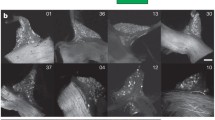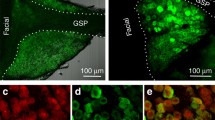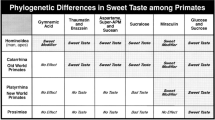Summary
The general properties of the glossopharyngeal taste system of the mud puppy,Necturus maculosus, were determined using standard electrophysiological recording techniques. Electrical activity from the whole nerve was quantified by an electronic integrator. The tongue was stimulated with diverse stimuli over an extended range of concentrations: the electrolytes, NaCl, KCl, CaCl2, CsCl, LiCl, and NH4C1; the amino acids, L-alanine, DL-alanine, and glycine; and stimuli representing the four basic taste qualities in humans, HCl (sour), quinine hydrochloride (bitter), sucrose (sweet), and NaCl (salty). The response pattern to all stimuli was identical: a phasic increase in activity which adapted nearly to baseline within 10 s (Fig. 4A), a response which was directly related to stimulus concentration (Fig. 4B). HCl was the most effective stimulus tested, whereas CsCl and sucrose were the least (Figs. 4, 6), However, the stimulus-response (SR) function for L-alanine suggested that saturation was reached and that threshold was far below 0.001 mol/l, the lowest concentration tested (Fig. 5B).
Punctate chemical stimulation revealed that the gustatory receptive field of the glossopharyngeal nerve was predominantly in the central portion of the tongue (Fig. 3). The distribution of the taste buds was studied with light and scanning electron microscopy and the location of the gustatory dermal papilla associated with each bud was mapped (Fig. 2). Comparison of this distribution with the receptive field showed regions with many buds but low responsiveness, areas in which the facial and vagus nerves probably contribute to the total taste system ofNecturus.
Similar content being viewed by others
Abbreviations
- SR :
-
stimulus concentration vs response magnitude
- L :
-
latency of response
- SEM :
-
scanning electron microscopy
References
Andersson B, Zotterman Y (1950) The water taste in the frog. Acta Physiol Scand 20:95–100
Beidler LM (1953) Properties of chemoreceptors of tongue of rat. J Neurophysiol 16:595–607
Caprio J (1975) High sensitivity of catfish taste receptors to amino acids. Comp Biochem Physiol 52A:247–251
Coghill EG (1902) The cranial nerves ofAmblystoma. J Comp Neurol 12:205–289
Drüner L (1901) Studien zur Anatomie der Zungenbein-, Kiemen- bogen-, und Kehlkopfmusculatur der Urodelen. I Theil. Zool Jahrb Anat 15:433–622
Farbman A, Yonkers J (1971) Fine structure of the taste bud in the mud puppy,Necturus maculosus. Am J Anat 131:353–370
Francis E (1934) The anatomy of the salamander. Clarendon Press, Oxford
Herrick CJ (1894) Studies from the neurological laboratory of Denison University: XI. The cranial nerves ofAmblystoma punctatum. J Comp Neurol 4:193–207
Kingsbury B (1895) On the brain ofNecturus maculatus. J Comp Neurol 5:139–205
Konishi J, Zotterman Y (1963) Taste functions in fish. In: Zotterman Y (ed) Olfaction and taste. Macmillan Company, New York, pp 215–233
Kusano K, Sato M (1957) Properties of fungiform papillae in frog's tongue. Jpn J Physiol 7:324–338
Kutyna FA, Bernard RA (1977) Effects of antidromic activity in gustatory nerve fibers on taste disc cells of the frog tongue. J Comp Physiol 118:291–306
Noble G (1931) The biology of the amphibia. McGraw-Hill, New York London
Norris H (1911) The rank ofNecturus among the tailed amphibians as indicated by the distribution of its cranial nerves. Proc Iowa Acad Sci 18:137–143
Oakley B, Jones LB, Kaliszewski JM (1979) Taste responses of the gerbil IXth nerve. Chem Senses Flavor 4:79–87
Pfaffmann C (1955) Gustatory nerve impulses in rat, cat, and rabbit. J Neurophysiol 18:429–440
Pumphrey R (1935) Nerve impulses from receptors in the mouth of the frog. J Cell Comp Physiol 6:457–467
Samanen DW, Bernard RA (1975) Scanning electron microscopy of the taste bud of the mud puppy,Necturus maculosus. In: Bailey G (ed) 33rd Annual Proceedings, Electron Microscopy Society of America. Claitor's Publishing Division, Baton Rouge, pp 530–531
Sayle M (1916) The reactions ofNecturus to stimuli received through the skin. J Anim Behav 6:81–102
Strong O (1895) The cranial nerves of amphibia. J Morphol 10:101–230
Tateda H (1961) Responses of catfish barbels to taste stimuli. Nature 192:343–344
West CHK, Bernard RA (1978) Intracellular characteristics and responses of taste bud and lingual cells of the mudpuppy. J Gen Physiol 72:305–326
Yamashita S (1963) Stimulating effectiveness of cations and anions on chemoreceptors in the frog tongue. Jpn J Physiol 13:54–63
Zottermann Y (1949) The response of the frog's taste fibers to the application of pure water. Acta Physiol Scand 18:181–189
Author information
Authors and Affiliations
Additional information
Supported in part by NIH Grant NS09168
The authors wish to thank the Electron Optics Laboratory at Michigan State University for assistance in the scanning electron microscopy and Mrs. G. Chapman of Florida State University for photographic reproductions in this publication. This work was submitted in partial fulfillment of the requirements for the M.S. and Ph.D. degrees to Michigan State University by the senior author.
Rights and permissions
About this article
Cite this article
Samanen, D.W., Bernard, R.A. Response properties of the glossopharyngeal taste system of the mud puppy (Necturus maculosus). J. Comp. Physiol. 143, 143–150 (1981). https://doi.org/10.1007/BF00606078
Accepted:
Issue Date:
DOI: https://doi.org/10.1007/BF00606078




